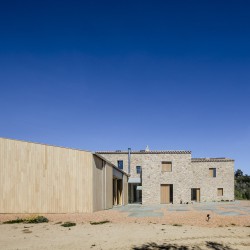05 AM Arquitectura . photos: © Adrià Goula . + divisare
Due to urban regulations, the “masia” had to be rebuilt according to the original plans and any future extension should be done as an integrated whole.
_
According to the analysis of the building and its surroundings, we discovered some auxiliary constructions mainly dedicated for farming and livestock activity. Hence, the extension project consists in two long volumes placed on one side of the building, respecting the original position of one of the auxiliary constructions and establishing a discreet relationship with the “masia” through the use of a single sloped roof in the second volume to stress the contrast between the two buildings. Our proposal resolved the connection of the “masia” and the extension volumes by the creation of an outdoor space that will articulate, with outdoor interstitial spaces, and define its interrelationship, as well as helping to understand the project as two different bodies. The extension volumes take the lengthened proportion of the original auxiliary constructions, using a porticoed structure and masonry walls. We also design the main façade with movable wooden panels, so it can be left entirely opened to the exterior when desired. On the other hand, the “masia” stresses the contrast between the massiveness of the exterior walls and the lightness of its roof by the design of a thin cornice.
The projects sought the right solution to preserve the essence of the vernacular architecture both in its composition and in its materiality, avoiding an explicit mimesis and incorporating the standard variations of contemporary architecture so that the project is integrated in its landscape.
Due to urban regulations, the “masia” had to be rebuilt according to the original plans and any future extension should be done as an integrated whole.
According to the analysis of the building and its surroundings, we discovered some auxiliary constructions mainly dedicated for farming and livestock activity. Hence, the extension project consists in two long volumes placed on one side of the building, respecting the original position of one of the auxiliary constructions and establishing a discreet relationship with the “masia” through the use of a single sloped roof in the second volume to stress the contrast between the two buildings. Our proposal resolved the connection of the “masia” and the extension volumes by the creation of an outdoor space that will articulate, with outdoor interstitial spaces, and define its interrelationship, as well as helping to understand the project as two different bodies. The extension volumes take the lengthened proportion of the original auxiliary constructions, using a porticoed structure and masonry walls. We also design the main façade with movable wooden panels, so it can be left entirely opened to the exterior when desired. On the other hand, the “masia” stresses the contrast between the massiveness of the exterior walls and the lightness of its roof by the design of a thin cornice.
The projects sought the right solution to preserve the essence of the vernacular architecture both in its composition and in its materiality, avoiding an explicit mimesis and incorporating the standard variations of contemporary architecture so that the project is integrated in its landscape.



























